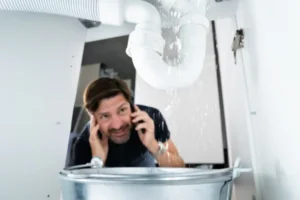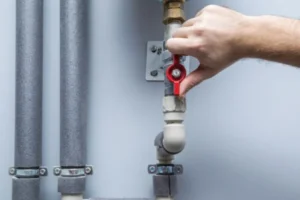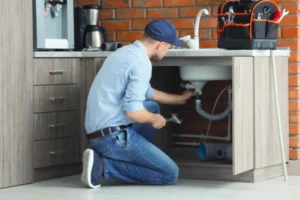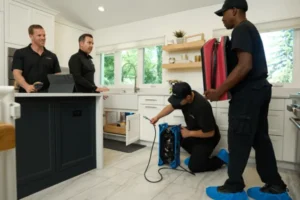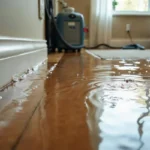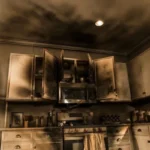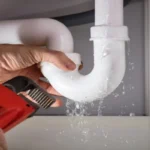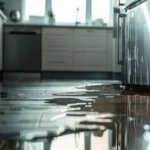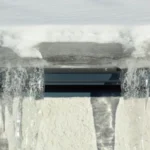Kitchen water damage can turn your day upside down, leaving you with a mess and questions about what to do next. It’s more than just cleaning up—it’s about preventing bigger problems in the future. Knowing how to spot trouble early and what steps to take if damage happens can save you time and money. In this guide, we’ll talk about prevention and restoration in simple terms to help you protect your kitchen and keep things running smoothly.
Common Causes of Kitchen Water Damage
Understanding what triggers kitchen flooding issues, such as leaks, clogs, or appliance failures, helps you identify problems early and take action before they escalate.
Leaking Appliances and Plumbing
Leaking kitchen pipes or appliances can cause severe water damage to your kitchen if ignored. Mold growth and cabinet damage often follow. Regular inspections help catch leaks early, saving you from expensive repairs and keeping your cooking space dry and safe.
Spills and Floods from Sinks or Dishwashers
Overflows from sinks or dishwashers are familiar sources of kitchen water issues. Faulty hoses or loose connections can exacerbate the issue. Regular checks and quick cleanups prevent bigger problems, keeping your kitchen safe and damage-free.
Roof or Ceiling Leaks Affecting the Kitchen
Roof or ceiling leaks can lead to water damage in the kitchen, causing mold and structural issues. Damaged shingles or clogged gutters are often to blame. Inspecting and fixing problems early prevents costly repairs and keeps your kitchen protected.
Signs of Kitchen Water Damage
You might notice warped or discolored flooring as a first sign of water damage in your kitchen. Pay attention to any swollen or soft cabinets, which can indicate moisture buildup. Don’t ignore mold in kitchen spaces or mildew growth either, as these are clear warnings that water damage is present.
Warped or Discolored Flooring
Warped or discolored flooring is often a clear sign of water damage in the kitchen. Buckling, stains, or curling typically indicate prolonged exposure to moisture. Investigate the source promptly and address it before the damage spreads and becomes more costly to repair.
Swollen or Soft Cabinets
Soft, swollen, or peeling cabinets can point to hidden kitchen water damage. A musty odor often accompanies prolonged exposure to moisture. Checking and repairing these issues early helps prevent more significant structural problems and expensive repairs in the future.
Mold or Mildew Growth
Mold or mildew in your kitchen often signals moisture problems. Dark patches or musty odors are common signs of mold. Addressing the source and cleaning affected areas promptly helps prevent further damage and protects your health and home.
Immediate Steps to Take After Kitchen Water Damage
After experiencing water damage in the kitchen, your first step is to shut off the water source to prevent further issues. Next, remove any excess water and dry all surfaces to minimize damage. Don’t forget to protect your appliances and electrical outlets to guarantee safety as you begin the cleanup process.
Shutting Off the Water Source
When a kitchen flood strikes, the first thing you need to do is shut off the water source to prevent further damage. Locate the main water valve, usually found near the sink or in the basement. Turn it clockwise until it’s fully closed. If the flood is caused by a specific appliance, unplug it to stop any leaks immediately. Quick action is essential!
Removing Excess Water and Drying Surfaces
Immediately start removing excess water to minimize damage and prevent the growth of mold in kitchen spaces. Use towels, mops, or a wet/dry vacuum to soak up standing water. Focus on areas like floors, countertops, and cabinets. After removing the water, open windows and doors to increase airflow. Utilize fans and dehumidifiers to thoroughly dry surfaces, ensuring your kitchen returns to a safe and dry environment.
Protecting Appliances and Electrical Outlets
Water damage can pose a significant risk to your kitchen appliances and electrical outlets, so it’s essential to act promptly. First, unplug all appliances to prevent electrical shock. Check for any visible damage and avoid using outlets that are damaged. If water has seeped into the wiring, call a professional electrician. Verify everything is completely dry before plugging appliances back in. Safety first!
Restoration and Repair Solutions
Quick, effective restoration is key to minimizing damage. Discover which repair methods are most effective for various types of kitchen water issues and learn how to recover safely.
Drying and Dehumidifying the Kitchen
When your kitchen faces water damage, drying and dehumidifying become essential steps in the restoration process. Start by removing any standing water with a wet/dry vacuum. Use fans and dehumidifiers to circulate air and lower humidity levels. Open windows if possible to enhance ventilation. Monitor the moisture levels until everything is completely dry, preventing mold growth and further damage.
Repairing Cabinets, Flooring, and Walls
Addressing water damage in your kitchen requires prompt attention to cabinet water damage repair, flooring, and walls to restore functionality and aesthetics. Start by evaluating the extent of the damage; replace warped or moldy materials. For cabinets, consider sanding and refinishing. When it comes to flooring, verify it’s scorched before installation. Finally, repair walls with fresh paint or drywall to complete the restoration.
Professional Kitchen Water Damage Services
Experiencing water damage in your kitchen can feel overwhelming, but professional kitchen water damage services are here to help you restore your space efficiently. They’ll assess the damage, extract water, and dry affected areas quickly to prevent mold growth. Plus, they offer repairs and replacements for damaged materials, ensuring your kitchen is safe and functional again. Trust the experts to handle the stress for you.
Preventing Future Kitchen Water Damage
Proactive maintenance and smart upgrades can reduce long-term risks. Discover practical strategies to maintain a dry, safe, and structurally sound kitchen.
Regular Appliance Maintenance
Regular appliance maintenance is essential for preventing future water damage in the kitchen. Check hoses and connections regularly for leaks or wear, and replace any damaged parts immediately. Clean your dishwasher filter and inspect your refrigerator’s drainage system to guarantee proper function. Don’t forget to descale your kettle and regularly check your washing machine’s drainage to avoid clogs and potential overflow.
Installing Water Sensors and Alarms
Installing water sensors and alarms can be a game-changer in protecting your kitchen from potential water damage. These devices detect leaks early, alerting you before significant issues arise. Position them near appliances like your dishwasher and refrigerator. With immediate notifications, you can take action quickly, minimizing damage and repair costs. Investing in these systems guarantees peace of mind while keeping your kitchen safe.
Tips for Long-Term Plumbing Safety
Maintaining long-term plumbing safety in your kitchen starts with a few smart habits. These simple steps can help prevent costly damage and reduce the risk of issues like leaking kitchen pipes. By staying proactive, you can protect your home and avoid unnecessary stress in the future. Here’s what to focus on:
- Inspect hoses regularly for signs of wear, cracks, or bulging. Replace them every few years to prevent sudden leaks.
- Monitor water pressure and install a pressure reducer if levels are consistently high.
- Locate your main shut-off valve and ensure everyone in your household knows how to use it in case of an emergency.
When to Call a Professional
Some water damage situations require expert help. Recognize the signs that indicate it’s time to hire a licensed plumber or restoration specialist for peace of mind.
Extensive Damage or Hidden Leaks
When faced with extensive damage or hidden leaks in your kitchen, it’s crucial to recognize the signs that warrant the expertise of a professional. Look for water stains, warped cabinetry, or persistent dampness. If you notice any unusual sounds or smells, don’t hesitate to call an expert. Addressing these issues promptly can prevent further damage and save you from costly repairs down the line.
Mold Growth or Structural Concerns
Water damage can lead to serious problems like mold growth and structural concerns. If you notice mold appearing, musty odors, or warped walls and floors, it’s time to call a professional. They can assess the damage, guarantee proper removal of mold, and address any structural issues before they worsen. Don’t wait—acting quickly can save you from costly repairs down the line.
Insurance Claims and Documentation
Navigating the complexities of insurance claims can be intimidating after experiencing moisture issues in the kitchen. You’ll need to document everything—take photos, keep receipts, and note repair timelines. Notify your insurer promptly and provide all necessary information. Don’t hesitate to ask questions if you’re unsure about the process. A clear understanding of your policy can help guarantee you receive the compensation you deserve.
Kitchen Water Damage Clean Up – Final Thoughts
Dealing with damage from water leaks in the kitchen can be stressful, but acting quickly makes a big difference. Learning the causes, spotting early signs, and taking preventive steps help protect your home. If damage happens, follow proper restoration practices or call professionals when needed. Staying proactive keeps your kitchen safe, dry, and free from bigger, costlier problems down the road.
Don’t Let Kitchen Water Damage Ruin Your Home—Get Expert Restoration Assistance Today!
Frequently Asked Questions
How Can I Identify Hidden Water Damage in My Kitchen?
What Insurance Coverage Exists for Kitchen Water Damage?
Can I Handle Water Damage Repairs Myself?
How Long Does It Take to Restore a Water-Damaged Kitchen?
What Materials Are Best for Water-Resistant Kitchen Renovations?


